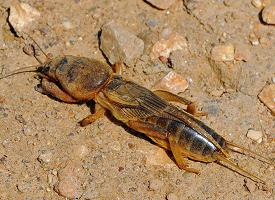
Súlyok és méretek
| Hossz | 15-tól 50-ig mm |
|---|
Állatleírás
The European mole cricket, scientifically known as Gryllotalpa gryllotalpa, is a fascinating insect that captivates the interest of entomologists and nature enthusiasts alike. This species is part of the Gryllotalpidae family, which is known for its unique adaptations for a subterranean lifestyle. The European mole cricket can be found across Europe and into parts of Asia, inhabiting a variety of environments that provide the moist soil conditions it prefers for digging and living underground.One of the most striking features of the European mole cricket is its physical appearance, which is perfectly adapted to its burrowing way of life. The insect boasts a robust, cylindrical body that can reach up to 5 centimeters in length, making it one of the larger cricket species. Its coloration varies from dark brown to a dusky black, providing excellent camouflage against the soil. The forelimbs of the European mole cricket are particularly noteworthy; they are broad, strong, and equipped with sharp claws, resembling the digging apparatus of a mole, hence the name. These specialized limbs enable the cricket to excavate elaborate tunnel systems with remarkable efficiency.
The hind legs of the European mole cricket are also adapted for its unique lifestyle but in a different manner. Unlike its relatives that are adept jumpers, the European mole cricket's hind legs are shorter and designed for pushing soil out of the way as it digs. Despite these adaptations for a life mostly underground, the European mole cricket is also capable of flight. Adults have a pair of long, membranous wings folded flat over their backs, which they use during the mating season to disperse and find partners.
The European mole cricket's diet is omnivorous, consisting of roots, tubers, and various invertebrates. This diet, combined with its burrowing activity, has led to the insect being considered a pest in agricultural and garden settings, where it can cause significant damage to crops and ornamental plants.
Reproduction in the European mole cricket involves a fascinating behavioral display. Males create specially constructed burrows that act as acoustic chambers to amplify their mating calls, which are produced by rubbing their wings together. These calls can be surprisingly loud, considering the cricket's size, and are used to attract females. After mating, the female lays her eggs in a chamber within the soil, where they will hatch, and the nymphs will develop, undergoing several molts before reaching adulthood.
Despite their reputation as pests, European mole crickets play an important role in the ecosystem. Their tunneling activities help to aerate the soil, improving its structure and fertility. Moreover, they are a source of food for a variety of predators, including birds, mammals, and other insects.
In conclusion, the European mole cricket is a remarkable creature that exemplifies the incredible adaptations that can arise in the insect world. Its specialized morphology and behaviors allow it to thrive in its subterranean niche, making it a subject of both admiration and management concern in its native habitat.
Új állatfotók
Top 10 állat
- Diana monkey (Cercopithecus diana)
- Dolphin gull (Leucophaeus scoresbii)
- Moustached guenon (Cercopithecus cephus)
- Galápagos tortoise (Geochelone nigra complex)
- Stone loach (Barbatula barbatula)
- Japanese spider crab (Macrocheira kaempferi)
- Colossal squid (Mesonychoteuthis hamiltoni)
- Common house mosquito (Culex pipiens)
- Common reed warbler (Acrocephalus scirpaceus)
- Sea urchins (Echinoidea)